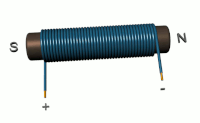
Photo from wikipedia
Permanent magnets together with yokes to concentrate the magnetic flux into a cylindrical air gap are widely employed in Kibble balances. These experiments require a uniform magnetic flux density along… Click to show full abstract
Permanent magnets together with yokes to concentrate the magnetic flux into a cylindrical air gap are widely employed in Kibble balances. These experiments require a uniform magnetic flux density along a vertical path, typically a substantial fraction of the length of the air gap. Fringe fields that are present at both ends of the air gap limit the region where the flux density does not change more than a certain relative fraction (here, $5\times 10^{-4}$ ) of the flux density in the center of the magnet system. By simply adding an iron ring with a rectangular cross section to the inner yoke at each end of the air gap, the effects of the fringe fields can be counteracted, and hence, the length of the region, where the flux density remains within a given tolerance band, is increased. Compared with the alternative, employing a taller magnet, the proposed method yields a magnet system with an extended region of a uniform field without significantly increasing the mass of the magnet system. Potential applications include compact and tabletop Kibble balances. We investigate possible adverse effects on the performance of the magnet system caused by the additional rings: magnetic field strength, coil-current effect, and a dependence of the radial field on the radial position in the field. No substantial disadvantage was found. Instead, the method presented here outperformed previously suggested methods to improve the radial dependence of the radial field, e.g., shorter outer yoke. In summary, adding rings to the inner yoke improves the uniformity of the field without a detrimental effect to function, cost, and form factor of the magnet system.
Journal Title: IEEE Transactions on Instrumentation and Measurement
Year Published: 2020
Link to full text (if available)
Share on Social Media: Sign Up to like & get
recommendations!